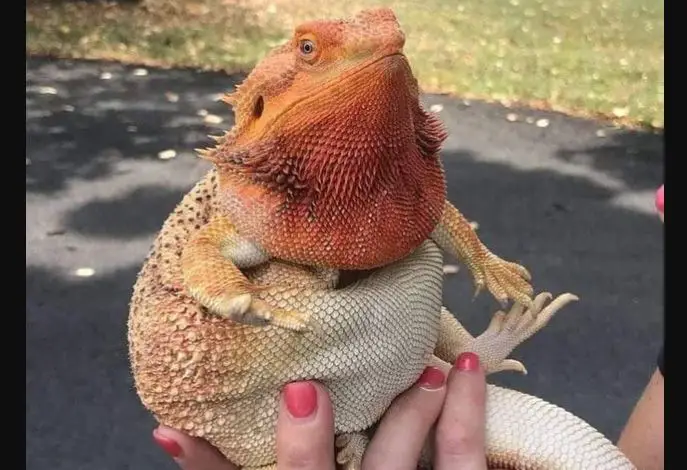The beardie is one of the largest reptiles you can keep indoors, it looks majestic and pretty hard to nourish. However, a bearded dragon fat belly is a concern of many owners.
Is it bad, how does it influence your pet’s health?
Keep reading and you’ll find out the answer!
Related Posts:
- Early Signs of MBD in Bearded Dragons
- How to Lower Humidity for Bearded Dragons
- Can Beardies Drink Bottled Water?
- How Do Beardies Sleep?
- How Long Can a Beardie Go Without Water?
- How to Pick Up a Beardie?
- Why Does My Beardie Stare at Me?
- 20+ Tips to Setup Beardie Tank
What Is a Bearded Dragon Fat Belly?
An obese belly is excess abdominal fat surrounding the organs in the BD stomach.
That is noticeable, you can see it easily from the top, there are obese pockets just kind of gathered over there even if the dragon is perking up, all that fat is still sagging and dragging across the table because too much fat really just weighs him down.
And when you hold your BD upright in your hand, the stomach flap of the healthy one will lean down, and squish a little bit as you touch it with your finger.
But is it really a BD obese belly or just a big stomach after a full meal?
Because the truth is, a bearded dragon’s belly gets much bigger, bloated, and round after eating.
It is a normal behavior of BD since they live in the wild, to adapt to the lack of food, a meal that can sustain the BD’s life for up to weeks.
The stomach will return to normal after pooped.
Furthermore, a big belly can oftentimes be a sign for a gravid female ( pregnant).
Why Does a Bearded Dragon Have a Fat Belly?
In most cases, a BD obese belly is synonymous with overweight. Every owner wants the best for their pet, they feed their beardie as much as they can eat.
Unfortunately, it is a problem with the BD because they are one of the reptiles that don’t necessarily show self-control with their dietary habitat.
They will naturally eat everything you give and become overweight.
Now you know “why is my beardie so obese”.
Beardie gets obese pretty quickly.
You may be wondering, my BD eats vegetables but it has an obese belly and my BD just looks obese but it is not fat at all.
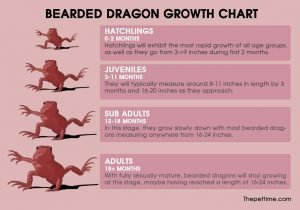
Beardie varies in weight depending on their type, age, and gender, so it’s hard to tell if your BD is too obese or not.
Baby BD is born at 2-3 grams, 3.5-4 inches long, and grows 2-3 inches every month after birth.
They reach their maximum size, which is around 19-24 inches long at 18-24 months.
Baby BD is getting obese quickly by the age of 6 months, they can gain 20% of their body weight every month.
250 grams is a minimum weight for a healthy adult BD, and 700-850 grams is big.
If your BD is above 900 grams, then that is when you can suspect that it is super overweight/fat.
Even over 800 grams can be too much if your BD is shorter than 22-24 inches.
Read more:
5 Signs of an Overweight Bearded Dragon

There are five little details determining if your BD might be overweight.
1. Abdominal Fat
As mentioned above, you can easily see the difference between healthy beardies and obese bearded dragons.
2. Bearded Dragons Fat Tail
You can look at your BD tail, if the base of its tail is thick, beefy, and squishes, this means there is a thin layer of excess obesity surrounding the entire surface of the tail, which should just be the compact structure used for balance.
3. Axillary Fat Pocket
It is an obese pad behind your BD forearms.
Normally, a beardie actually doesn’t have any obese pads back there, it is essentially just a storage site for surplus fat in the wild if the beardie was going through a period of time with an abundance of food.
4. Bearded Dragons Fat Jowls
You usually notice that as a beardie fat chin, it is a loose hanging skin underneath the chin, right below the section, which is often known as a bearded that creating the beardie name we use today.
Besides, you may notice the similarity between beardie fat jowl and human fat chin.
5. Cranial Fat Pads
They are two little squish pads right behind the beardie eyes.
You do not need to tough it to identify the difference, you can see it on your beardie head from the side.
Beardie fat pads have the same size as BD eyeball, it is soft and elastic.
How Are Bearded Dragons Impacted?
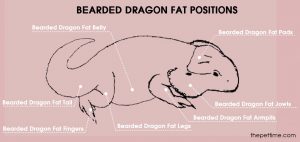
Beardie is famous for its excellent adaptability, they can eat a large range of wide food, from worms, fruits to vegetables.
They are typically hardy and easy to feed.
However, that isn’t to say that beardie never gets sick or can’t develop serious health problems.
There are up to 15 must-know BD health issues, disease including:
- Metabolic Bone Disease occurs when BD either aren’t absorbing calcium properly or aren’t receiving enough, to begin with;
- Yellow Fungus discolors a BD’s scales, making them appear yellow, as the scales become discolored, they can actually break off and reveal raw and extremely sensitive tissue;
- Parasites;
- Cancer;
- Beardie sunken eyes….
Those above are the common health problems of beardie, which every BD can get.
Related: Best Calcium Powder For Bearded Dragons
How Does Being Overweight Affect Bearded Dragons?
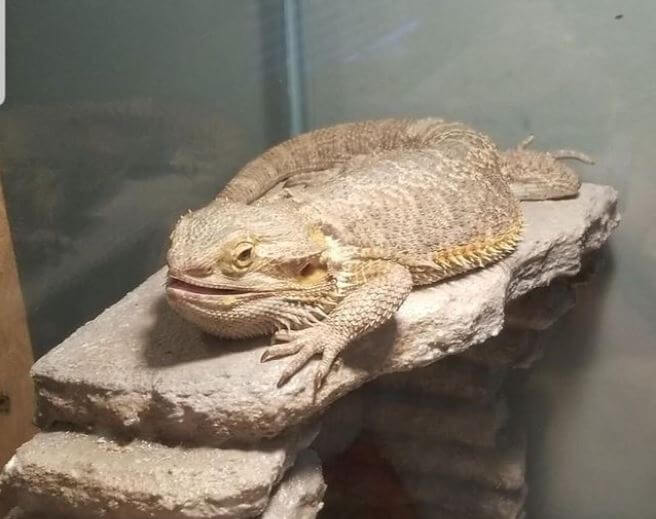
Nobody should be overweight, including BD. Many owners know BD through the obese beardie meme and love that cute fat bearded dragon.
But being fatty means that your BD has to carry more weight, all of that extra obese puts pressure on their bodies, especially the bones.
As a result, the skeleton will be weakened.
Furthermore, it interferes with everyday activities like moving, climbing, jumping.
You may notice your beardie moving more slowly, staying in one place all day, and breathing hard, making wheezing and difficult sounds after being obese.
Nevertheless, the bearded dragons with a fat belly has a much higher risk of fatty liver disease (about 67% higher than the normal one).
You can search the term “Bearded dragon fatty liver disease” on the internet to know more about the harmful and negative effects of it on beardie health.
Other serious reasons that BD should not be obese are prone to prolapses and Dystocia.
Female BD might have hormonal disorders and difficult birth.
Don’t stop there, misfortunes never come alone, overweight BD has a high potential to get organ dysfunction where an organ does not perform its expected function.
Organ failure is organ dysfunction to such a degree that normal homeostasis cannot be maintained without external clinical intervention.
All of these problems lead to a single consequence-shortened beardie lifespan.
What to Do to Make Your Bearded Dragon Lose Weight?
Like many reptiles, beardie is omnivores and eat almost anything they can put in his mouth.
In the wild beardie mainly eat animals, they makeup about 75% of their diet and can include crickets, cockroaches, worms, and even small creatures such as mice.
Greens, vegetables, and fruit make up the other 20% to 25% of their diet.
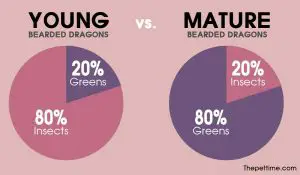
Generally, beardie can eat meat in the form of insects, an adult beardie can eat around 15-20 crickets per feeding which should last around 15 minutes.
Crickets can be replaced by king worms, waxworms, earthworms, cockroaches, locusts, butter worms, silkworms, phoenix worms, dubia roaches, mealworms, redworms…
Make sure you get your BD’s meal from a reliable feeder insect supplier.
Especially, never feed your BD bugs you find outside of the house because it may infect your pet with parasites.
Don’t forget that your BD is being overweight, change the ratio of vegetables and meat in its diet.
Beardie can eat more green vegetables than you might think: peas, green beans, courgette, butternut squash, sweet potato, bell pepper, broccoli, acorn squash, cabbage, kohlrabi, parsnip, yellow squash, asparagus, celery, okra, kale, collards, parsley, clover, dandelion greens, turnip greens, mustard greens, endive, rocket, coriander, sprouts, tomatoes, blueberries, grated carrots, banana, grapes, and cucumber.
Remember to add fruits in an obese belly BD: figs, melon, apples, mango, papaya, dates, peaches, plums, kiwi, strawberries, guava, pears, grapes, raisins, apricots…
A balanced diet with plenty of green vegetables is necessary but not enough for a fat belly bearded dragon.
There are five easy tips to helps your obese beardie regain a fit and healthy physique.
- Firstly, let your BD eat early in the early morning so that it can burn its “bearded dragon fat belly” throughout the day.
- Secondly, do not let your BD eat too much and too many times a day. Once a day for an adult BD and 2-3 times a day for a cute baby BD is enough.
- Thirdly, remove high-calorie food like fatty worms from their daily diet.
- Fourthly, let your BD move around the tank at least 1 hour a day.
- Finally, add the necessary nutrients for BD such as capsules and milk thistle.
Related Posts:
Conclusion
There is no way to keep your beardie always healthy and lovely, but we can minimize the risk by checking your pet’s weight and expression regularly.
Bearded dragon fat belly looks cute, however, that cuteness must be exchanged by your beardie’s health, so, be considerate! Anyway, if you still want a cute fat bearded dragon, you should properly turn your attention to the beardie’s brother: bearded dragon fat-tailed gecko.
Key points for fat bellies on bearded dragons:
A bearded dragon’s belly can provide valuable insights into its health and well-being. If you notice your bearded dragon has a fat belly, it’s essential to understand the potential causes and take appropriate action. Here are key points to consider:
1. Normal Appearance:
- Bearded dragons typically have a plump, rounded belly when well-fed and healthy.
- This rounded appearance is considered normal.
2. Variation Among Individuals:
- The size and shape of a bearded dragon’s belly can vary among individuals.
- Factors such as age, sex, and overall health play a role in this variation.
3. Overfeeding and Obesity:
- Overfeeding can lead to obesity in bearded dragons, resulting in a noticeably fat belly.
- Obesity can have adverse effects on their health and longevity.
4. Proper Feeding Guidelines:
- Follow appropriate feeding guidelines for your bearded dragon’s age and size to avoid overfeeding.
- Young dragons require more frequent feedings, while adults can eat less often.
5. Metabolic Bone Disease (MBD):
- A swollen or fat belly can sometimes be a sign of underlying health issues, such as metabolic bone disease (MBD).
- MBD results from a lack of calcium or poor calcium absorption and can affect bone health.
6. Egg Binding (Females):
- Female bearded dragons can experience a fat or swollen belly due to egg binding, which occurs when they have difficulty laying eggs.
- Egg binding is a medical emergency that requires prompt veterinary attention.
7. Impaction:
- Ingesting foreign objects or inappropriate substrate material can cause impaction, leading to a swollen belly.
- Ensure a safe and clean enclosure to prevent impaction.
8. Internal Parasites:
- Certain internal parasites, such as worms, can lead to gastrointestinal issues and a swollen belly.
- Regular fecal exams and deworming can help prevent and address parasite problems.
9. Breeding and Gravid Females:
- Female bearded dragons can develop a fat belly when gravid (carrying eggs) during the breeding season.
- Gravid females require a suitable nesting area to lay their eggs.
10. Seek Veterinary Consultation: – If you are concerned about your bearded dragon’s fat belly or if it’s accompanied by other symptoms like lethargy, loss of appetite, or unusual behavior, consult a reptile veterinarian for a thorough evaluation.
11. Proper Husbandry Practices: – Maintain proper husbandry practices, including providing appropriate temperatures, UVB lighting, and a balanced diet with calcium supplementation to promote your bearded dragon’s health.
In summary, while a plump belly is normal for a healthy bearded dragon, it’s crucial to monitor your pet’s overall well-being and seek veterinary advice if you notice a persistently fat or swollen belly, especially if it’s accompanied by concerning symptoms. Proper husbandry, feeding practices, and regular veterinary care are essential to ensure the long-term health and happiness of your bearded dragon.
Further Reading:
- Carolina Custom Cages Terrarium Review
- 8 Best Basking Rocks for Beardie: What Is the Best Choice?
- 10 Best Thermometers for Beardie: How to Choose the Best One?
- 5 Best Beardie Lighting Setups for Beardie Lovers
- 9 Best Heat Lamps for Beardie: Natural Habitat Provided

